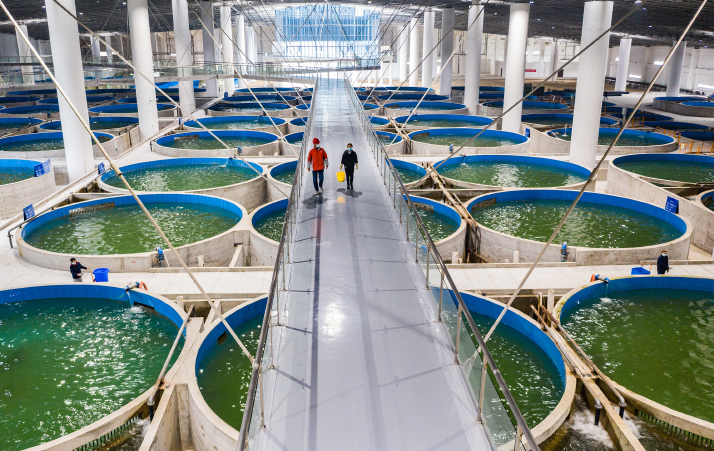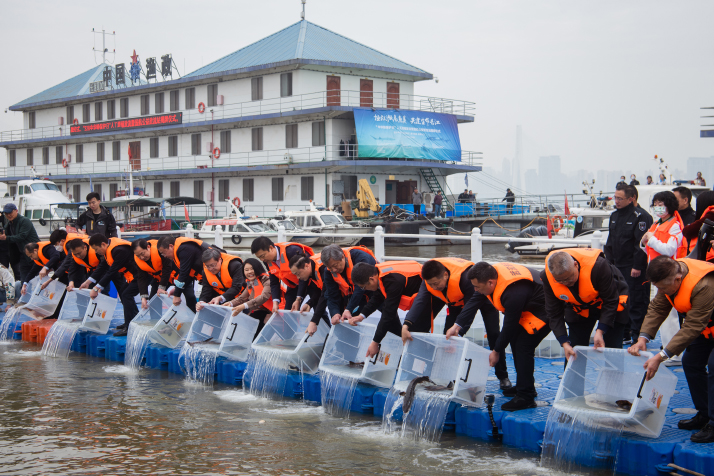| China |
| More efforts necessary for the survival of a fish species | |
|
|
 A breeding workshop of the Chinese Sturgeon Research Institute of China Three Gorges Corporation in Yichang, Hubei Province on January 11, 2022 (XINHUA)
Intertwining his life with the fate of the Chinese sturgeon—a species teetering on the brink of extinction—was not a calculated career move for Du Hejun, who is now in charge of providing technological support for species conservation at the Chinese Sturgeon Research Institute (CSRI).
Du, who holds a Ph.D. from the Institute of Hydrobiology at the Chinese Academy of Sciences, was first drawn to the conservation of this ancient species in 2010. "My research on fish began while I was pursuing my master's degree," he told Oriental Outlook magazine. "It was during field research that I witnessed the alarming rate at which fish resources were being depleted." The species he set out to study and protect was already in dire straits. Known as the "king fish" of the Yangtze River, the longest river in both China and Asia as well as the third longest in the world, the Chinese or Yangtze sturgeon, sometimes dubbed a "living fossil," boasts a lineage dating back 140 million years, making it one of the oldest vertebrates on Earth. Its remarkable rarity has earned it the nickname "the aquatic giant panda," though in truth it is even rarer than the beloved bear. The Yangtze sturgeon is listed as an animal under first-class state protection in China. In July 2022, the International Union for Conservation of Nature reclassified the species from "critically endangered" to "extinct in the wild." This grim status means that the survival of the Yangtze sturgeon now depends largely on artificial breeding. Despite the challenges, the Chinese sturgeon continues its precarious journey to reestablish its presence in the wild, aided by decades of tireless efforts by conservationists and researchers alike. A growing team The institute Du works at was established in 1982 in Yichang, Hubei Province. It is China's first research organization dedicated to the study of rare fish species and was established in response to the construction of the country's major Three Gorges Dam hydroelectric project in Yichang. During his first two years at the CSRI, Du's research focused on aquaculture at a temporary Chinese sturgeon breeding base. The fish there faced harsh living conditions. Chinese sturgeon individuals are large in size and accustomed to long migration routes. The fish begins its rather complex life cycle in the Yangtze, then moves to sea, where it spends roughly 90 percent of its life cycle growing and maturing, and eventually returns to the Yangtze to spawn. In the 1970s, thousands of wild Chinese sturgeons migrated up the Yangtze annually. However, in subsequent years, their number plummeted due to several detrimental factors, including the disruption of migration routes and overfishing. Alarmingly, since 2017, no natural reproduction has been observed. Zhu Xin, Du's more experienced colleague, joined the CSRI in 1991, tasked with the care of juvenile sturgeons. "It is a fragile species," Zhu told Xinhua News Agency. "Despite a single mature sturgeon having the potential to lay between 300,000 to 1.3 million eggs, fewer than 10 percent of these eggs typically survive to hatch into fry in the wild within five days of spawning," he said. "Even under the meticulous conditions of aquaculture, with water sourced from the Yangtze and temperatures regulated to match natural conditions, fry survival rates hovered between a mere 1 and 10 percent." Feeding the sturgeon also proved challenging. The team initially sourced water angleworms, mosquito larvae, and small fish and shrimps from the river as food, which inadvertently introduced bacteria that could lead to fish diseases. Furthermore, the sturgeon's delicate underbelly was susceptible to abrasions from the tank's bottom, leaving them vulnerable to infections that, while nearly undetectable under a microscope, posed significant health risks. Another complication in conservation efforts was the inability to determine the sex of Chinese sturgeon from birth to adulthood based on external characteristics, making it difficult to manage controlled breeding and sex ratios for release into the wild. Without any existing models to emulate, the CSRI researchers were like pioneers navigating uncharted waters. "We initially believed that mimicking their natural habitat would ensure the sturgeon's survival, but the reality of it all proved far more complex," Zhu said.  People release artificially bred Chinese sturgeons into the Yangtze in Wuhan, Hubei Province, on March 28, 2023 (XINHUA)
Swimmingly ever after? The past decade has seen an influx of young professionals joining the CSRI team. Yang Jing joined in 2017, right after obtaining her Ph.D. in animal genetics, breeding and reproduction from Northwest A&F University, one of China's leading research universities. "For me, dedicating my efforts to the research and conservation of the Chinese sturgeon is more than a job. It's a personal mission," she told Xinhua. Her academic journey, which included research on the crested ibis—a national first-class protected species—during her master's studies, seamlessly transitioned to a focus on aquatic life in her doctoral research. Today, the institute houses a passionate team of 63 researchers. Their work has coincided with broader ecological initiatives to improve the Yangtze's environment, which bodes well for the migratory journey of the river's native species. Notably, in January 2020, China initiated a comprehensive fishing ban on the Yangtze, followed by the enactment of the Yangtze River Protection Law in December 2020, underscoring the country's commitment to safeguarding rare and endangered species and rehabilitating important habitats. To further these efforts, over 266 green factories and 28 green industrial parks have been developed along the riverbanks since 2021. In tandem with these environmental policies, the CSRI has achieved significant research milestones. After overcoming obstacles related to water quality, temperature control, fish disease and aquaculture equipment, the institute pioneered a technique that increased the survival rate of juvenile Chinese sturgeon to more than 70 percent. In 2020, they unveiled a DNA molecular method that can determine the sex of newly hatched fish with just a small sample of body fluid or fin tissue. In September 2023, after a decade-long project, Du and his team completed the sequencing and assembly of the Chinese sturgeon's entire genome, a monumental achievement. This breakthrough has been likened to creating a genetic "compass" for the species. It lays the groundwork for informed population management and accurate parentage identification. "With artificial breeding techniques now refined, our next objective is to restore wild sturgeon populations," Zhu said. Every year, the CSRI conducts releases in Yichang. In 2023, no fewer than 200,000 Chinese sturgeons were released into the Yangtze. Jiang Wei, another CSRI researcher, explained that the released fish are monitored using various tagging methods to observe their migration routes, with monitoring stations strategically placed along the river. According to Jiang, since the implementation of the 10-year fishing ban on the Yangtze River, the survival rate of released Chinese sturgeons in the mainstream of the river has improved significantly, with their sea-entry rate climbing from 30-40 percent to approximately 70 percent. However, the anticipated increase in the number of sturgeons returning to the Yangtze from the sea has not yet materialized. "Addressing this challenge requires a concerted effort that unites regions and departments in a joint and systematic push for advanced scientific research," Jiang said. (Print Edition Title: Way to the Wild) Copyedited by Elsbeth van Paridon Comments to yuanyuan@cicgamericas.com |
|
||||||||||||||||||||||||||||
|